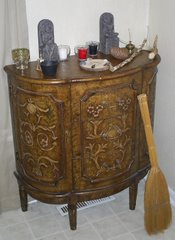Astarte is also known as Astarat and Astoreth. She is an incarnation of Ishtar and Inanna. This Semitic Goddess was worshipped by the Syrians, Canaanites (today called Palestinians), Phoenicians, Egyptians and other Semitic Tribes. King Solomon built a Temple to Her as Astoreth, near Jerusalem.
Astarte was worshipped as many things, to the Egyptians, She was honored as a Goddess of War and tenacity, to the Semites, She was a Goddess of Love and Fertility. Among the Greeks She was transposed into the Goddess of Love Aphrodite. In the Bible, She is referred to as "the abomination". Considering Her widespread devotion in Biblical times, the attempts to discredit the Goddess are not surprising.
The Bull and the Dove are especially sacred to Astarte and Astoreth. The Goddess is often pictured wearing horns. Astoreth is sometimes pictured wearing the head of a Bull. The Dove is associated with many Middle-Eastern Goddess rites. A Dove perches atop many Asheras, (tall moon poles) that marked the "High Places" were outdoor Goddess rituals were frequently held.
The bountiful qualities of the Great Goddess are reflected in all the principle Goddesses of the Meditteranean and Middle-East. Homage was paid to the Goddesses in the form of honey, beer, wine, incense, and animals. These offerings were an important part of honoring the Goddess and insuring future blessings for self and the community.
The Egg is a sacred symbol of Astarte, representing fecundity, new life and the powers of the Goddess. The Pomegranate, the "fruit bearing eggs" is an important part of Her sacred rites. Pomegranite is also central to the rites of Kore-Persephone, as well as other Goddesses.
The worship of Astarte spread far and wide, and in time, She was worshipped by the Phillistines, the Greeks, the Romans, the Sicilians, and in many parts of Europe and Africa. The Great Goddess Astarte was also worshipped as Freya by the Norse, Indrani by the Hindus, by the Celts as Danu, and by the Egyptians as Hathor.
Like Artemis & Diana, She often carries a bow and arrows, and is the center of many millenia of devotion.
[Information was gathered from: spiralgoddess.com]
Tuesday, March 6, 2007
Subscribe to:
Post Comments (Atom)





No comments:
Post a Comment